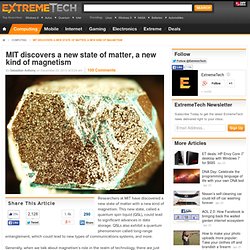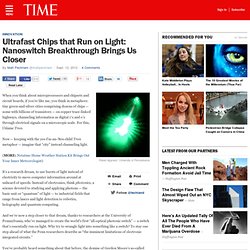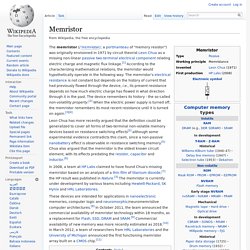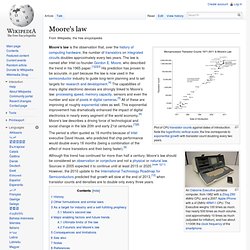

Synthetic Brains. New Electronic Materials. Quantum Computing. Dell cooks up an Android PC on a HDMI stick. Thin-clients are great for security and keeping everyone on the same software platform page but they can be a pain to set up.

Dell's Wyse division, which has been doing thin-clients for decades, has cooked up a new way to avoid the thin-client setup trouble: An Android-powered, universal-thin client called the Wyse Cloud Connect. The Cloud Connect is about as large as an over-sized USB stick. While it comes with a USB port, to use it you'll need a device such as an HDTV monitor or a modern laptop with an HDMI or Mobile High-Definition Link (MHL) port. To "install" it, all you need do is plug Cloud Connect into the device, plug in a power-source with the mini-USB port, and you're ready for business. Mystery Particle To Make Devices Even Tinier. A strange, newly discovered particle could shrink a laptop computer's hard drive to the size of a peanut and an iPod's drive to the size of a rice grain.

The particle, called a skyrmion, is more stable and less power-hungry than its conventional, magnetic cousin. Besides storing data in ultra compact media, skyrmions could lead to faster computers that combine storage with processing power and usher in smaller and smaller devices that have the same computing power as a desktop machine. NEWS: Tiny Robotic Compound Eyes Unveiled Kristen von Bergmann and her colleagues, led by Roland Wiesendanger at the University of Hamburg in Germany, report their findings in today's issue of Science. While the name sounds like an evil creature from a fantasy novel – it comes from Tony Skyrme, a British physicist who first theorized the particle's existence in 1962 -- skyrmions are tiny magnetic fields that surround groups of atoms.
Magnetic fields are the basis for data storage. MIT discovers a new state of matter, a new kind of magnetism. Researchers at MIT have discovered a new state of matter with a new kind of magnetism.

This new state, called a quantum spin liquid (QSL), could lead to significant advances in data storage. QSLs also exhibit a quantum phenomenon called long-range entanglement, which could lead to new types of communications systems, and more. Generally, when we talk about magnetism’s role in the realm of technology, there are just two types: Ferromagnetism and antiferromagnetism. Ferromagnetism has been known about for centuries, and is the underlying force behind your compass’s spinning needle or the permanent bar magnets you played with at school. In ferromagnets, the spin (i.e. charge) of every electron is aligned in the same direction, causing two distinct poles. “Papertab” paper tablet is your flexible friend. Toward An FSF-Endorsable Embedded Processor. Ultrafast Chips that Run on Light: Nanoswitch Breakthrough Brings Us Closer. When you think about microprocessors and chipsets and circuit boards, if you’re like me, you think in metaphors: tiny green-and-silver cities comprising dozens of chips — some with billions of transistors — on copper trace-linked highways, channeling information as digital 1′s and o’s through electrical signals on a microscopic scale.

For this, I blame Tron. Now — keeping with the yes-I’m-an-’80s-child Tron metaphor — imagine that “city” instead channeling light. (MORE: Netatmo Home Weather Station Kit Brings Out Your Inner Meteorologist) It’s a research dream, to use bursts of light instead of electricity to move computer information around at unheard of speeds. Instead of electronics, think photonics, a science devoted to studying and applying photons — the basic unit or “quantum” of light — to industrial fields that range from lasers and light detection to robotics, holography and quantum computing.
How’d the Penn research team create their photonic switch? According to Penn News: Single Photon Optics Transmitter Slows the Speed of Light. Memristor. Leon Chua has more recently argued that the definition could be generalized to cover all forms of two-terminal non-volatile memory devices based on resistance switching effects[2] although some experimental evidence contradicts this claim, since a non-passive nanobattery effect is observable in resistance switching memory.[5] Chua also argued that the memristor is the oldest known circuit element, with its effects predating the resistor, capacitor and inductor.[6] Background[edit] Conceptual symmetries of resistor, capacitor, inductor, and memristor.

In his 1971 paper, Chua extrapolated a conceptual symmetry between the nonlinear resistor (voltage vs. current), nonlinear capacitor (voltage vs. charge) and nonlinear inductor (magnetic flux linkage vs. current). He then inferred the possibility of a memristor as another fundamental nonlinear circuit element linking magnetic flux and charge. Moore's law. Moore's law is the observation that, over the history of computing hardware, the number of transistors on integrated circuits doubles approximately every two years.

The law is named after Intel co-founder Gordon E. Moore, who described the trend in his 1965 paper.[1][2][3] His prediction has proven to be accurate, in part because the law is now used in the semiconductor industry to guide long-term planning and to set targets for research and development.[4] The capabilities of many digital electronic devices are strongly linked to Moore's law: processing speed, memory capacity, sensors and even the number and size of pixels in digital cameras.[5] All of these are improving at roughly exponential rates as well. Three-dimensional integrated circuit. In electronics, a three-dimensional integrated circuit (3D IC) is a chip in which two or more layers of active electronic components are integrated both vertically and horizontally into a single circuit.

The semiconductor industry is pursuing this technology in many different forms, but it is not yet widely used; consequently, the definition is still somewhat fluid. 3D ICs vs. 3D packaging[edit] Notable 3D chips[edit] In 2004, Intel presented a 3D version of the Pentium 4 CPU.[1] The chip was manufactured with two dies using face-to-face stacking, which allowed a dense via structure. Backside TSVs are used for I/O and power supply.